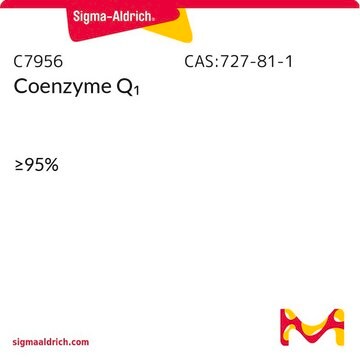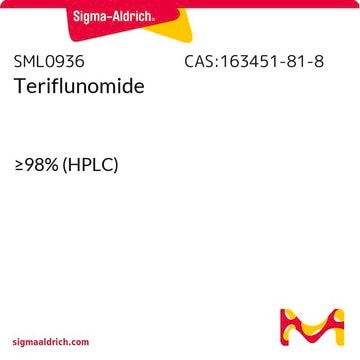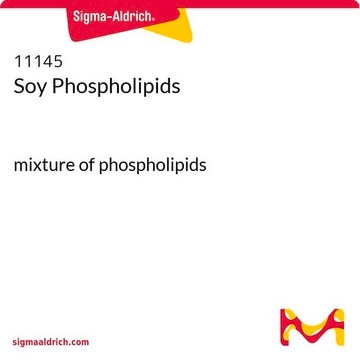D7911
Decylubiquinone
≥97% (HPLC)
Synonym(s):
2,3-Dimethoxy-5-methyl-6-decyl-1,4-benzoquinone
Sign Into View Organizational & Contract Pricing
All Photos(4)
About This Item
Empirical Formula (Hill Notation):
C19H30O4
CAS Number:
Molecular Weight:
322.44
MDL number:
UNSPSC Code:
12162212
PubChem Substance ID:
NACRES:
NA.25
Recommended Products
Assay
≥97% (HPLC)
form
liquid
storage temp.
−20°C
SMILES string
CCCCCCCCCCC1=C(C)C(=O)C(OC)=C(OC)C1=O
InChI
1S/C19H30O4/c1-5-6-7-8-9-10-11-12-13-15-14(2)16(20)18(22-3)19(23-4)17(15)21/h5-13H2,1-4H3
InChI key
VMEGFMNVSYVVOM-UHFFFAOYSA-N
General description
Mitochondrial permeability transition pore (MPTP) inhibitor.
Ubiquinone analog.
Application
- Lysosomal Ca(2+) as a mediator of palmitate-induced lipotoxicity.: This study explores the role of decylubiquinone in modulating lysosomal Ca(2+) levels, providing insights into mechanisms of lipotoxicity and potential therapeutic applications in metabolic diseases (Oh et al., 2023).
- Quinone binding site in a type VI sulfide:quinone oxidoreductase.: This paper investigates the binding dynamics of decylubiquinone in sulfide:quinone oxidoreductase, shedding light on its role in microbial respiration and potential biotechnological applications (Miklovics et al., 2022).
- Protective role of Decylubiquinone against secondary melanoma at lung in B16F10 induced mice.: The study demonstrates the anti-metastatic properties of decylubiquinone in a melanoma mouse model, highlighting its potential as a therapeutic agent in cancer treatment (Chatterjee et al., 2023).
- Decylubiquinone Inhibits Colorectal Cancer Growth Through Upregulating Sirtuin2.: This research identifies decylubiquinone as an inhibitor of colorectal cancer growth by modulating Sirtuin2 expression, suggesting its application in cancer therapeutics (Li et al., 2021).
Storage Class Code
10 - Combustible liquids
WGK
WGK 3
Flash Point(F)
Not applicable
Flash Point(C)
Not applicable
Personal Protective Equipment
dust mask type N95 (US), Eyeshields, Gloves
Certificates of Analysis (COA)
Search for Certificates of Analysis (COA) by entering the products Lot/Batch Number. Lot and Batch Numbers can be found on a product’s label following the words ‘Lot’ or ‘Batch’.
Already Own This Product?
Find documentation for the products that you have recently purchased in the Document Library.
Customers Also Viewed
Zeqi Zheng et al.
International journal of nanomedicine, 15, 4501-4521 (2020-07-02)
Elevation of blood homocysteine (Hcy) level (hyperhomocysteinemia) is a risk factor for cardiovascular disorders and is closely associated with endothelial dysfunction. The present study aims to investigate the protective effect and underlying mechanism of nanoscale selenium (Nano-Se) in Hcy-mediated vascular
Hannah R Bridges et al.
Nature communications, 11(1), 5261-5261 (2020-10-18)
Respiratory complex I (NADH:ubiquinone oxidoreductase) captures the free energy from oxidising NADH and reducing ubiquinone to drive protons across the mitochondrial inner membrane and power oxidative phosphorylation. Recent cryo-EM analyses have produced near-complete models of the mammalian complex, but leave
Samuel S W Szeto et al.
The Journal of biological chemistry, 287(27), 22509-22520 (2012-05-11)
Succinate dehydrogenase (SDH), also known as complex II, is required for respiratory growth; it couples the oxidation of succinate to the reduction of ubiquinone. The enzyme is composed of two domains. A membrane-extrinsic catalytic domain composed of the Sdh1p and
Hongzhi Li et al.
Biochimica et biophysica acta, 1863(9), 2266-2273 (2017-06-01)
Our previous study generated a series of cybrids containing mitochondria of synaptosomes from mice at different ages. The following functional analysis on these cybrids revealed an age-dependent decline of mitochondrial function. To understand the underlying mechanisms that contribute to the
Yasser Ahmed Mahmmoud et al.
The Journal of biological chemistry, 280(30), 27776-27782 (2005-05-28)
FXYD domain-containing proteins are tissue-specific regulators of the Na,K-ATPase that have been shown to have significant physiological implications. Information about the sites of interaction between some FXYD proteins and subunits of the Na,K-ATPase is beginning to emerge. We previously identified
Our team of scientists has experience in all areas of research including Life Science, Material Science, Chemical Synthesis, Chromatography, Analytical and many others.
Contact Technical Service










